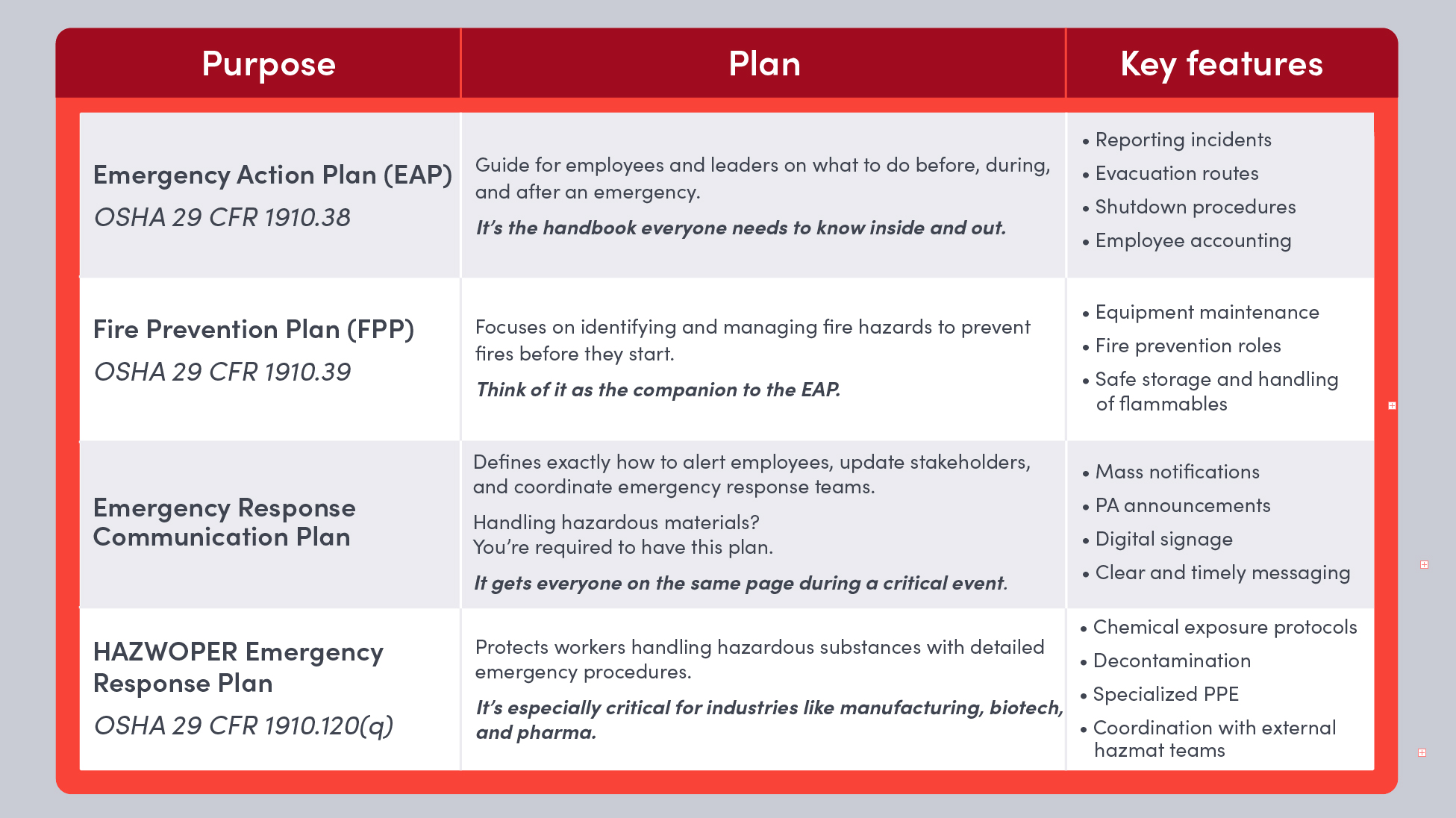In an unpredictable world, it’s not a matter of if an emergency will happen, it’s when. Yet too many plans sit on a shelf or in a forgotten folder, essentially useless. Did you tick the box to create the plan? Sure. But can your team actually use it under pressure to keep people safe and operations running?
That’s the real test.
When plans aren’t clear, practiced, and accessible, people freeze or scramble, communication breaks down, and emergencies escalate fast.
In this post, we’ll break down the OSHA-mandated plans every workplace needs and how to bring them to life so your team can respond confidently when it counts.
Make these four plans the base of your emergency response
The four plans below are the foundation of a strong emergency response strategy.
- Emergency Action Plan (EAP) - OSHA 29 CFR 1910.38
- Fire Prevention Plan (FPP) - OSHA 29 CFR 1910.39
- Emergency Response Communication Plan
- HAZWOPER Emergency Response Plan - OSHA 29 CFR 1910.120(q)
Three align directly with OSHA standards, while the Emergency Response Communication Plan focuses on how to coordinate alerts and information. Meeting these regulations isn’t optional. It’s essential for protecting your people and your business.
Use the chart to see what your plan already covers or to build one from the ground up.

{{protip-1}}
Remember: OSHA doesn’t just expect plans on paper. Your emergency strategy must be accessible, practiced, and auditable. Tabletop drills, gap assessments, and regular updates aren’t just nice to have. They’re critical for compliance and true readiness.
Move your emergency plans from paper to practice
Having the right plans is only the first step. To stay compliant and ready for real emergencies, make sure your plans are quick to find, regularly drilled, and communicated clearly. Here’s how to make that happen:
- Keep plans within reach. OSHA requires that emergency plans be readily accessible to all employees. That means storing digital copies and posting them in visible areas—across all your locations—so they can be accessed instantly, even if a network goes down.
- Train until it’s second nature. Emergency plans aren’t just there to check a box. They’re meant to be used. Regulations like OSHA 1910.38 call for training at hire, after role changes, and whenever plans get updated. Running regular drills will help your team build muscle memory and make sure everyone’s prepared.
- Send clear alerts every time—instantly. Communication is one of the most critical parts of any emergency plan. OSHA calls for reliable, easy-to-understand alerts that reach everyone, fast. That means using multiple channels (PA, SMS, signage, etc.) and having clear messaging ready to go for any kind of situation.
- Learn and improve after every drill. The strongest plans improve over time. They include ways to monitor risks, act early, and adapt before problems escalate. Every drill and real event is a chance to review, learn, and strengthen your response for next time.
{{protip-2}}
What a strong emergency response looks like in action
You’ve got the plans. You’ve done the training. So how do you know it’s working? Here’s what success looks like when a real emergency hits:
- Everyone knows what to do. No hesitation, no chaos. Just quick, confident action from every team member.
- Alerts go out instantly. Clear, timely messages hit every channel and reach everyone who needs to act—while all communications are logged for compliance and review.
- Roles and responses are documented. Every step is recorded, creating a clear, verifiable timeline for audits and after-action analysis.
- Each event makes your plan stronger. Whether it’s a drill or the real thing, you review what worked, what didn’t, and refine from there.
—
Compliance is the starting point, not the finish line. But a plan on paper isn’t enough. Real emergency response lives in your people, your processes, and how you communicate when it counts.
Ready to put your plans into action? Download our emergency notifications ebook to learn how to send fast, targeted alerts with Envoy Emergency Notifications.
Pro tip: Walk through each plan with your team to spot gaps and test how it holds up in practice.
Pro tip: Test your emergency notification system regularly and document it. A reliable alert system and audit trail help meet OSHA requirements and prove you’re ready when it counts.
Read more
Searching for a visitor management solution? Learn what to look out for and how to choose the best tech for your team.
Managing your space well doesn’t have to be difficult. But if you want to be successful, you need the right approach.
A well-run workplace can set your team up for success. Learn why workplace management matters and how to do it right.
Workplace security is critical to the future of your business. Learn why it matters, what threats to watch for, and how to strengthen your workplace security plan.
In this post, we’ll explore what workplace compliance is and how to build a compliance culture for your organization.
With more folks sending personal packages to the workplace, having a sound mailroom management system in place is key.









